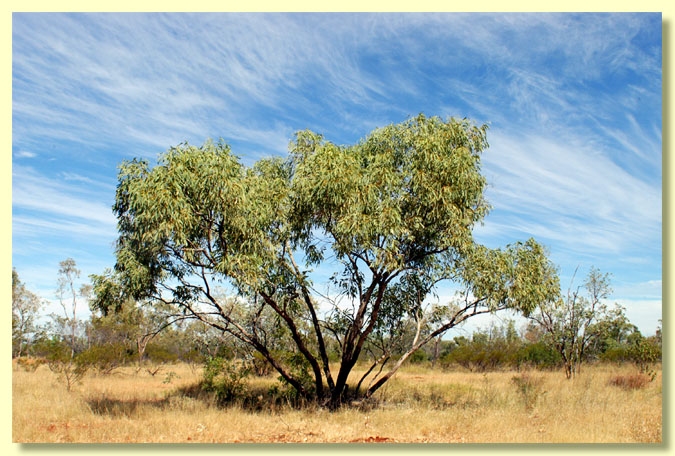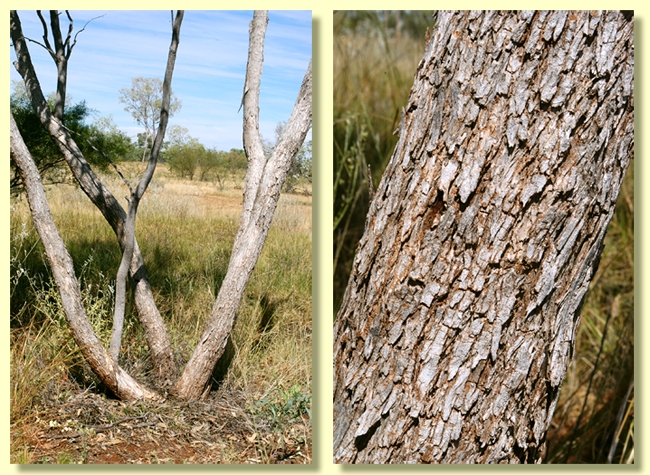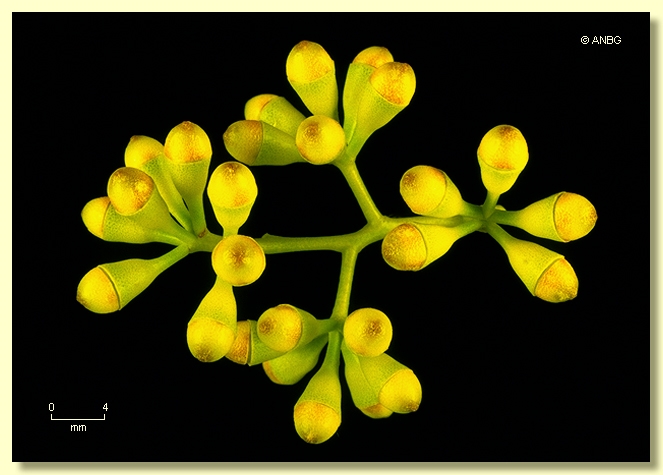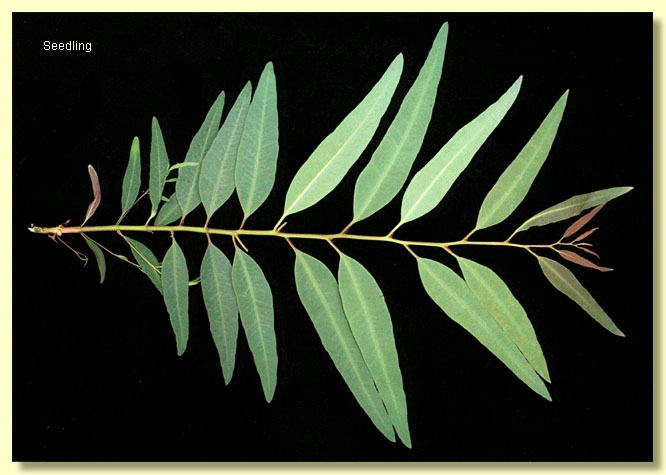Euclid - Online edition
Eucalyptus leucophylla
Eucalyptus | Symphyomyrtus | Adnataria | Apicales | Aquilonares | Fortes
Eucalyptus leucophylla Domin, Biblioth. Bot. 89: 464 (1928).
T: Queensland: near Cloncurry, Feb 1910, K.Domin 7192; holo: PR.
Eucalyptus tropica Cambage ex Maiden, Crit. Revis. Eucalyptus 8: 6 (1929). T: Queensland: near Corella River, 30 miles [48 km] N of Cloncurry on road to Granada, 30 Aug 1913, R.H.Cambage 4163; holo: NSW; iso BRI, K.
Mallee or tree to 6 m tall. Forming a lignotuber.
Bark rough throughout, box-type, finely fissured, grey to whitish grey.
Branchlets lacking oil glands in the pith; normally non-glaucous, occasionally glaucous.
Juvenile growth (coppice or field seedlings to 50 cm): stems rounded in cross-section; juvenile leaves always petiolate, alternate, lanceolate, 6.5–12(15) cm long, 3.5–5 cm wide, dull grey-green to green.
Adult leaves alternate, petioles 0.6–2 cm long; blade usually lanceolate, sometimes falcate, 8–14(17.5) cm long, 1.2–2.6 cm wide, base tapering to petiole, apex pointed, margin entire, concolorous, dull, light green to grey-green to rarely glaucous, side-veins at an angle greater than 45° to midrib, reticulation dense to very dense, intramarginal vein present, sometimes almost confluent with the margin, oil glands sparse, intersectional.
Inflorescence terminal and axillary compound, peduncles 0.4–1 cm long; umbels 7-flowered, rarely 3-flowered, pedicels 0.2–0.6 cm long). Mature buds obovoid to ovoid to pear-shaped, 0.6–0.7 cm long, 0.3–0.4 cm wide, scar present (outer operculum shed early), operculum broadly conical to rounded, stamens irregularly flexed, all fertile, anthers adnate, more or less cuboid to globoid, dehiscing by lateral slits, style straight, long, stigma blunt, locules 4(5), the placentae each with 4 vertical ovule rows. Flowers creamy white.
Fruit pedicellate ( pedicels 0.1–0.7 cm long), cupular to rarely obconical, 0.4–0.7 cm long, (0.4)0.5–0.6(0.75) cm wide, normally non-glaucous, rarely glaucous, disc narrow, descending, valves 4(5), slightly exserted or near the rim.
Seeds dark brown, 2–3 mm long, flattened-ovoid, sometimes pointed at one end, dorsal surface shallowly reticulate, hilum ventral.
Cultivated seedlings (measured at ca node 10): cotyledons small, reniform; stems square in cross-section; leaves always petiolate, opposite for 6 to 7 nodes then becoming alternate, lanceolate, 9.5–10.7 cm long, 1.5–2.1 cm long, base tapering, apex pointed, dull, grey-green, slightly discolorous.
Flowering has been recorded in March and August.
Eucalyptus leucophylla is a small tree or sometimes a mallee principally from the Camooweal – Mt Isa – Djarra – Cloncurry – Kajabbi area of north-western Queensland, but also collected west of Winton between Whyrallah homestead and the Diamantina River. It is characterised by its box bark to the small branches, its dull light green to grey-green adult leaves and the thick-walled cupular fruit.
It is closely related to E. microneura from the Croydon area and further east. E. leucophylla differs by having cup-shaped fruit (funnel-shaped in E. microneura) and buds and fruit that are normally not glaucous (normally glaucous in E. microneura). In the Cloncurry area there is a localised glaucous form of E. leucophylla which was originally described as E. tropica. In EUCLID we have placed this in synonomy under E. leucophylla. Two other tropical boxes close to E. leucophylla are E. distans and E. chlorophylla. E. distans can be distinguished by having smaller fruit with prominently exserted valves. E. chlorphylla is easily distinguished by having glossy adult leaves.
Eucalyptus leucophylla is also very closely related to two other boxes from the Kimberley and Pilbara regions of Western Australia, E. limitaris and E. xerothermica. These three species are weakly separated by the size of their fruit and the texture of their leaves. E. xerothermica from the Pilbara has the largest fruit of the group and normally slightly thicker-textured leaves than the other two. E. limitaris from the Kimberley has slightly smaller fruit always longer than wide compared with E. xerothermica, but slightly larger fruit than E. leucophylla. Both E. limitaris and E. leucophylla have thinner-textured leaves than E. xerothermica. Some overlap in the fruit dimensions occurs although the shapes differ slightly. The relationship between these three species and the Top End endemic E. patellaris, plus the two glaucous Kimberley endemics, E. tephrodes and E. argillacea, needs further research.
Within its area of occurrence, E. leucophylla may be confused with three other more distantly related boxes, i.e. E. normantonensis, E. tectifica and E. microtheca. E. normantonensis occurs in Central Australia just north of Alice Springs and sporadically in north-western and central Queensland. It differs by having a rough stocking of box bark with the upper bark smooth and often chocolate brown. Its adult leaves are initially dull becoming glossy green with maturity, and its flowers have an outer whorl of infertile stamens. E. tectifica and E. microtheca stretch right across northern Australia from the Gulf of Carpentaria in north-western Queensland through the Top End of the Northern Territory to the Kimberley in Western Australia. Both species belongs to the group of boxes with thin-walled fruit, where the disc is not prominent and where the fruit is easily crushed between the fingers. E. leucophylla has a narrow but prominent disc and is not easily crushed between the fingers.
In the classification of Brooker (2000) Eucalyptus leucophylla belongs in Eucalyptus subgenus Symphyomyrtus section Adnataria (the boxes) because the buds have two opercula, ovules are in four rows, seeds are flattened-ovoid, cotyledons are reniform, and anthers are rigid on the staminal filaments. Within section Adnataria, E. leucophylla belongs to a subgroup of box species with tropical distribution, series Aquilonares subseries Fortes, having inflorescences terminal on the branchlets, adult leaves very densely reticulate and fruit that are not fragile and have valves more or less at rim level when dehisced. The species making up subseries Fortes are E. leptophleba, E. leucophylla, E. koolpinensis, E. patellaris, E. oligantha and E. pruinosa. Three more tropical box species, E. limitaris, E. tephrodes and E. xerothermica, published since 2000 also belong in subseries Fortes.
Eucalyptus leucophylla: Greek leuco -, white and phyllon -, leaf.














